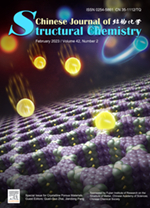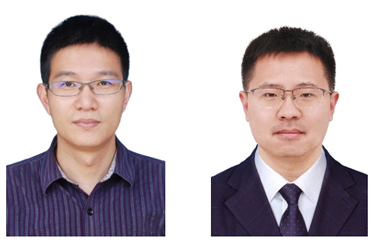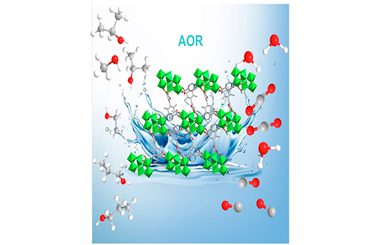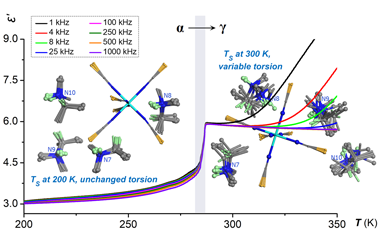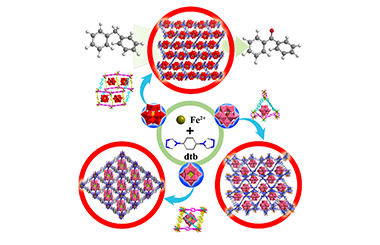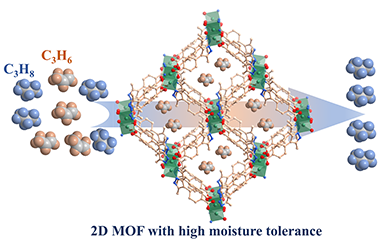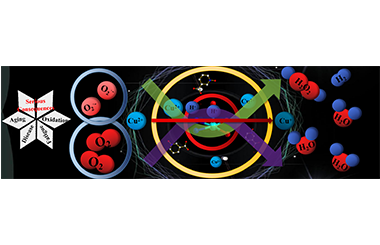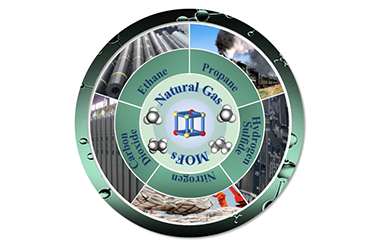-
Short CommunicationAdenine-mediated amide-containing metal-organic framework toward one-step ethylene purification from a ternary mixture
Fang-Jing Guo, Ning Yang, Hong-Xin Li, Han Fang, Dong-Xu Xue*
Chin. J. Struct. Chem., 2023, 42: 100012. DOI: 10.1016/j.cjsc.2023.100012
February 15, 2023
ABSTRACT
An amide-containing adenine-mediated rod metal-organic framework was solvothermally constructed by means of mixed-linker approach, which exhibits both C2H2 and C2H6 selective adsorption, resulting in one-step ethylene purification from a ternary mixture of C2H2/C2H4/C2H6 as proved by not only IAST prediction, but also column breakthrough experiments. -
Short CommunicationA 3D Ni8-cluster-based MOF as a molecular electrocatalyst for alcohol oxidation in alkaline media
Wei-Juan Chen, Tian-Yu Zhang, Xue-Qian Wu*, Yong-Shuang Li, Yunling Liu, Ya-Pan Wu, Zhao-Bo He, Dong-Sheng Li*
Chin. J. Struct. Chem., 2023, 42: 100018. DOI: 10.1016/j.cjsc.2023.100018
February 15, 2023
-
ArticleSmart crystalline frameworks constructed with bisquinoxaline-based component for multi-stimulus luminescent sensing materials
Peng-da Liu, Ao-gang Liu, Peng-min Wang, Yuan Chen* , Bao Li *
Chin. J. Struct. Chem., 2023, 42: 100001. DOI: 10.1016/j.cjsc.2022.100001
February 15, 2023
Metal-organic framework, Hydrogen bonding organic framework, Luminescent sening, Bisquinoxaline group, Sensor
ABSTRACT
Three crystalline porous frameworks (HOF and MOF) based on a bisquinoxaline-containing tetra-topic linker are obtained, which show excellent sensing properties and fluorescence recognition. -
ArticleSolid-state molecular dynamics of a torsion-variable ammonium embedded in a deformable supramolecular framework
Hui Xiao, Liwen Ding, Jingyan Liu, Zhihui Jia, Liming Cao, Ziyi Du* , Chunting He
Chin. J. Struct. Chem., 2023, 42: 100003. DOI: 10.1016/j.cjsc.2022.100003
February 15, 2023
Solid-state molecular dynamics, Supramolecular framework, Phase transition, Dielectric
ABSTRACT
The switchable molecular dynamics and order-disorder transformation of (i-PrNHMe2)+ cation embedded in a deformable {[Ni(NCS)6]4–} supramolecular framework accompanied by solid-state structural phase transitions are reported, finding the confined swinging or flipping of the cation as a whole is assisted by a synergistic change of its torsion angle.
-
ArticleControl of pore environment in nickel-based metal-organic frameworks for SF6/N2 separation
Hao-Ran Liu, Shao-Min Wang, Yong-Li Dong, Su-Tao Zheng, Shuang Ni, Jie Xu, Qing-Yuan Yang*
Chin. J. Struct. Chem., 2023, 42: 100022. DOI: 10.1016/j.cjsc.2023.100022
February 15, 2023SF6/N2 separation, Greenhouse gas, Metal-organic frameworks, Adsorption
ABSTRACT
Ni(ina)(bdc)0.5 has tetrahedral and trigonal-pyramidal cages for respectively capturing SF6 and N2, which reduces their competition for adsorption sites. The smaller window diameter of Ni(3-min)(bdc)0.5 is more conducive to forming stronger hostguest interactions of gas molecules and frames, which improves the selectivity and adsorption capacity of SF6. -
ArticlePolyoxometalate-encapsulated metal-organic frameworks with diverse cages for the C–H bond oxidation of alkylbenzenes
Yue Wang, Ze-Xuan Liu, Xing-Pu Zhao, Yuan-Yuan Ma*, Si-Meng Zhang, Wen-Jing Cui, Jing Du*, Zhan-Gang Han*
Chin. J. Struct. Chem., 2023, 42: 100011. DOI: 10.1016/j.cjsc.2023.100011
February 15, 2023Polyoxometalate, Metal-organic framework, Heterogeneous catalysis, C–H bond oxidation
ABSTRACT
Three Fe-incorporated polyoxometalate-encapsulated metal-organic frameworks present 3-D POM-based metal-organic host-guest framework structures with diverse cages, which exhibited excellent catalytic performance toward C–H bond oxidation of diphenylmethane along with good recyclability and structural stability.
-
ArticleRobust microporous metal-organic framework with high moisture tolerance for efficient separation of propylene from propane
Shan-Qing Yang, Lei Zhou, Bo Xing, Ying-Hui Zhang, Tong-Liang Hu*
Chin. J. Struct. Chem., 2023, 42: 100004. DOI: 10.1016/j.cjsc.2022.100004
February 15, 2023
Metal-organic framework, Adsorptive separation, Propylene/propane separation, Energy efficient
ABSTRACT
A copper-based robust microporous MOF, Cu-Hmpba, constructed by the bifunctional pyridylcarboxylate ligand is reported. It shows good water stability and C3H6/C3H8 selectivity. This work provides the insight of synthesizing stable MOF materials for separating high-value chemicals.
-
ArticleWater-soluble copper-based simulated enzyme: Biomimetic synthesis and activities in vitro
Yifan Kang, Xiaochen Sun, Yunluo Wang, Yanan Zhang, Wenhuan Huang*
Chin. J. Struct. Chem., 2023, 42: 100046. DOI: 10.1016/j.cjsc.2023.100046
February 15, 2023
SOD activity, Catecholase activity, Cytotoxicity
ABSTRACT
Two copper(II) complexes with excellent SOD and catecholase activities are obtained by solvothermal reaction. The SOD activity and catecholase activity are directly affected by the coordination configuration of the central metal atom and the ability of the complex to accept electrons. It has good application potential in the clinical biomedical field in the future. -
ReviewAdvances in metal-organic frameworks for efficient separation and purification of natural gas
Haiming Yang, Linhao Xue, Xiaogang Yang*, Hui Xu, Junkuo Gao*
Chin. J. Struct. Chem., 2023, 42: 100034. DOI: 10.1016/j.cjsc.2023.100034
February 15, 2023
metal-organic frameworks, adsorption, separation, natural gas
ABSTRACT
Natural gas is an essential chemical raw material and a promising clean energy source. The recent research progress of using metal-organic frameworks adsorbent for the separation of natural gas was summarized. Also, bottlenecks and possible research directions for further exploration were discussed.

